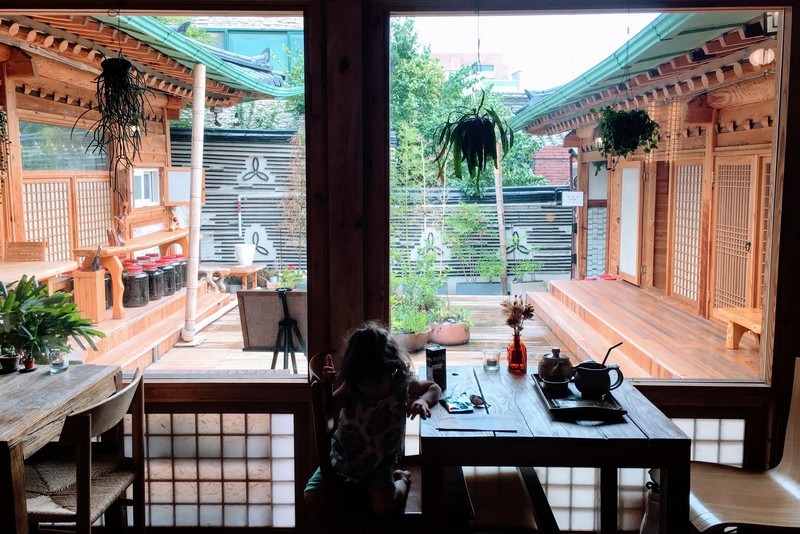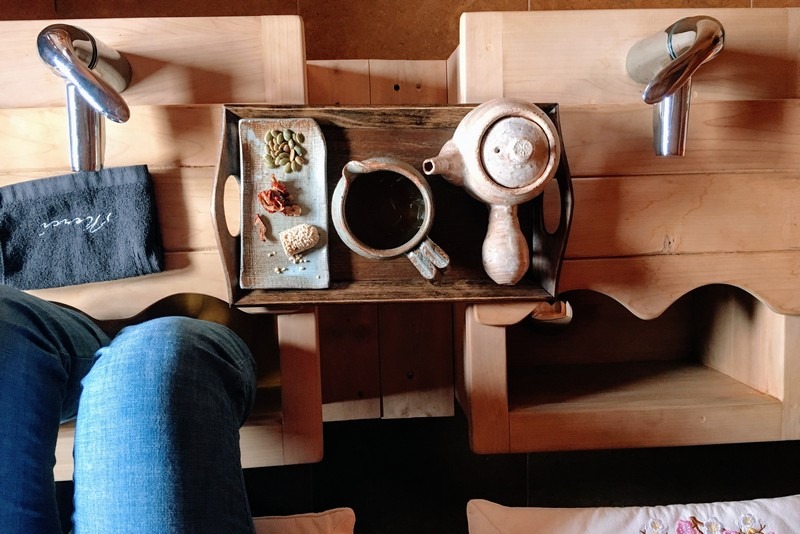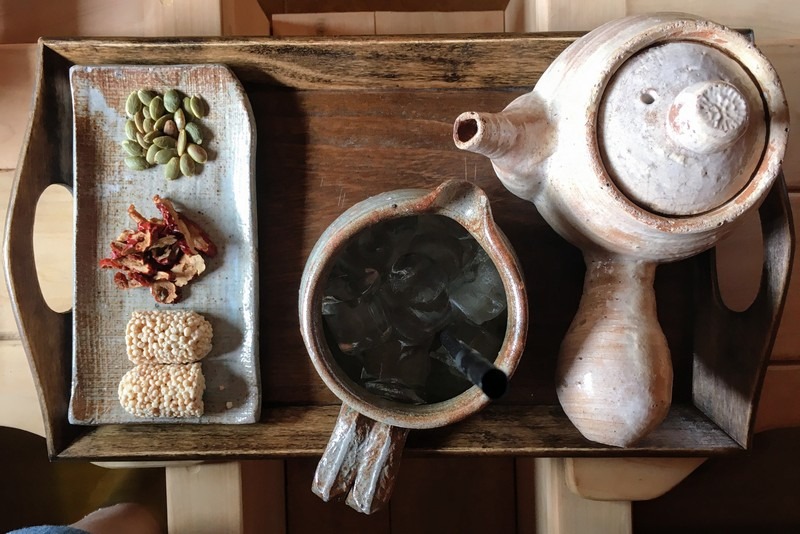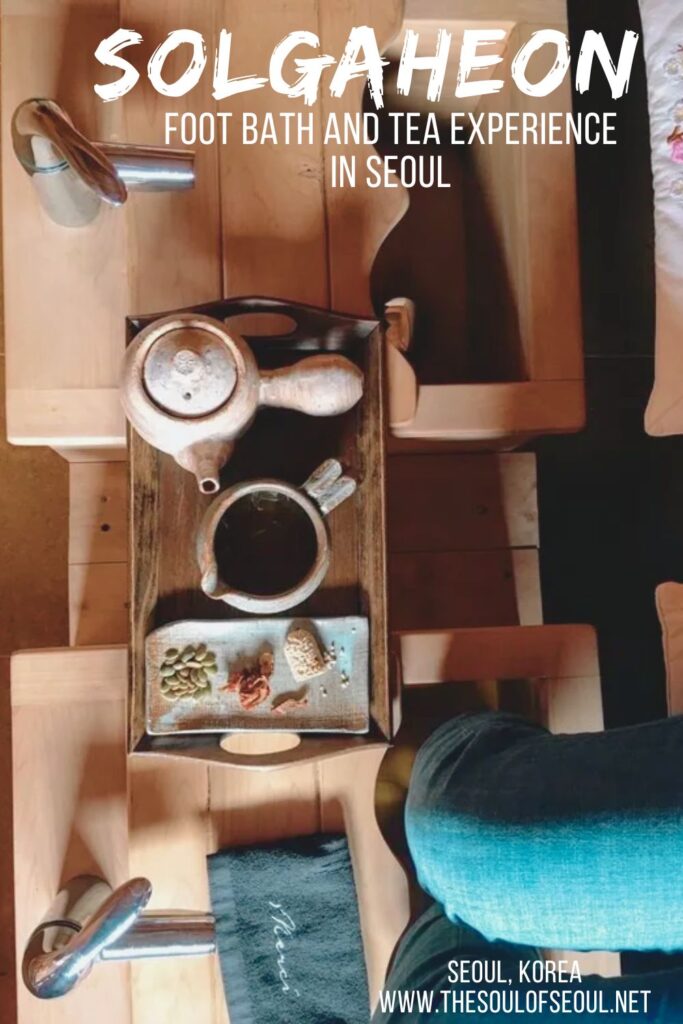Solgaheon: A Foot Bath & Tea in Bukchon
Last Updated on March 29, 2024
(This cafe has closed unfortunately. For another option in the area, head to Tea Therapy where you can also sip tea and have a foot bath.)
Bukchon has a handful of experience programs set in traditional Hanok houses that I have been able to try over the years and I have enjoyed every single one of them. There’s just something about the unique traditional setting, the opportunity to learn a bit more about the Korean culture in a different way and the history of the area.
A few weeks ago, I headed over to Solgaheon (솔가헌) which specializes in rejuvenation for the immune system through medicinal herbal teas. Walk down a tiny alley and you’ll be welcomed into the beautiful courtyard of a traditional Hanok house hidden inside.

(This post contains affiliate links, which means I receive a certain percentage of a sale if you purchase after clicking. Thank you for your support.)
Basic Info
Address: 54 Jahamun-ro Jongno-gu, Seoul (서울 종로구 자하문로 54)
Hours: Monday – Saturday: 11:ooam ~ 9:00pm; Sunday: 1:00pm ~ 9:00pm
Cost: W10,000 ~ W25,000
Amenities: wheelchair accessible, wifi, restrooms, disabled toilets

What To Do
The Bukchon area can sometimes be overwhelming. The first time I went, I couldn’t even find the most popular Hanok Alley let alone a Hanok house. They just seemed to be hidden. If you can find them (and you should check out this post if you want to know where to start in the Bukchon area the hot spots you should find in Bukchon ASAP and this post about all of ), hidden inside are numerous experience programs and tea houses that make the area worth a good hunt.

The Hanok house at Solgaheon is easy to find just across the street from Tongin Traditional Market and is immediately welcoming with an open courtyard and it’s easy to see just what the experience will entail upon entrance what with the tiny cypress wood baths and faucets just near the door. Guests are welcomed inside to a simple cafe area with tables and chairs where they can peruse the menu and choose a tea to drink as well as choose which foot bath they’d like.
This experience cafe is also a healing cafe that pulls upon the holistic care approach that I have so enjoyed learning about while living here in Korea.

If you’re like me and want to learn about the different teas, herbal care and other holistic approaches, be sure to head to the Yangnyeongsi Herbal Market which also hosts a festival in the autumn to not only get free holistic care like acupuncture and free medical consultations but provides tons of info too. If you head to the market, you can also get a tea made just for you and your ailments.
Back to this experience though, at Solgaheon there are eight foot baths in total so if there are a lot of people, you may need to enjoy your tea inside and wait a bit. We went on a Sunday though and were two of only four people there so you may have the place to yourself if you’re lucky. There are four foot baths outside in the courtyard and four more in an inner area.

Solgaheon also has healing rooms which are made from natural hardwood, pure red clay tiles, elvan stone plates and germanium flooring. All of the natural products benefit the body with better blood circulation and allows the release of internal toxins through your sweat pores. I opted for tea and a foot bath as I had my darling two year old with me who would likely not let me really rest in a healing room.
The foot baths and tea time will take about two hours in total. Guests are invited to enjoy their time, relax and let the natural aesthetics of the surroundings soothe. The staff speaks Korean generally but can help with some English information if in doubt, but it’s a pretty easy experience to understand.

I would suggest asking for the plate of traditional snacks as well. They were delicious and just a nice little sweetness to munch on while we dipped our toes in a relaxing bath.
I took my toddler with me who did not have her own bath but enjoyed the surroundings and managed to sit comfortably in my lap and enjoy some foot bath healing as well.
This was a great experience and there are plenty to be had in the area. Here are a few more things to do near Gyeongbokgung Palace to try if you have the time:
- Kum Bak Yeon: This is an awesome gold leaf experience that I’ve done twice. decorate material with gold leaf in traditional Korean patterns. It’s fun and you’ll have something beautiful to take home. (Book your gold leaf experience easily here.)
- Head to the Traditional Korean Tea Institute to partake and learn about a traditional tea ceremony. Bukchon is definitely THE spot to learn about the traditional teas and ceremonies surrounding them in Korea. (Book your tea experience here.)
- One of the most popular activities in Bukchon is to dress up in Hanboks, traditional Korean dresses, and stroll the historic streets. It’s a must do in the area.

If you need some help choosing the tea for you, here are some and what they can do for you:
- Bowee Tea: for weak stomachs and indigestion
- Cheongan Tea: for tired and bloodshot eyes and a weak liver
- Shintong Tea: for cold symptoms, body fatigue and stress
- Saengki Tea: to restore energy and vitality
- Anjeong Tea: for anxiety and insomnia
- Gaggeun Tea: to strengthen muscles and bones
- Chaegam Tea: for bloating

Specialty teas which cost a bit more include:
- Hwangjae Tea: the best for rejuvinating and invigorating (with deer antler)
- Nokyongssanghwa: for recuperating from the modern stressors (deer antler)
Teas can be purchased hot or iced and you can get one refill as well.
If you want to learn more about the various Korean tea options from flower teas to herbal teas, root teas, and grain teas, check out this guide to Korean teas so you know more about what you can get when you visit the traditional tea houses in Korea.
I absolutely loved this experience and would highly recommend it. Another experience to check out in the area is Kum Bak Yeon, a gold leaf experience set in a Hanok house as well. Check both of them out if you have time!
Did you like this post? Pin It!


